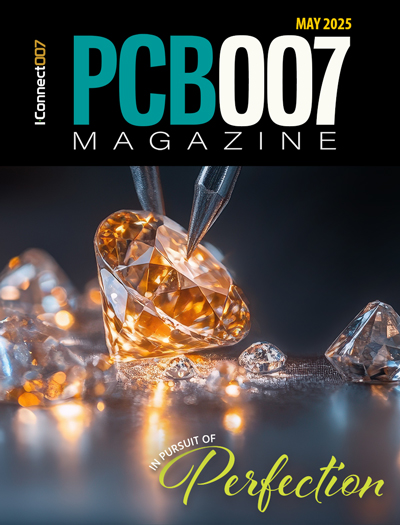-

- News
- Books
Featured Books
- pcb007 Magazine
Latest Issues
Current Issue
Sales: From Pitch to PO
From the first cold call to finally receiving that first purchase order, the July PCB007 Magazine breaks down some critical parts of the sales stack. To up your sales game, read on!

The Hole Truth: Via Integrity in an HDI World
From the drilled hole to registration across multiple sequential lamination cycles, to the quality of your copper plating, via reliability in an HDI world is becoming an ever-greater challenge. This month we look at “The Hole Truth,” from creating the “perfect” via to how you can assure via quality and reliability, the first time, every time.

In Pursuit of Perfection: Defect Reduction
For bare PCB board fabrication, defect reduction is a critical aspect of a company's bottom line profitability. In this issue, we examine how imaging, etching, and plating processes can provide information and insight into reducing defects and increasing yields.
- Articles
- Columns
- Links
- Media kit
||| MENU - pcb007 Magazine
High-Efficient Beam Sources for Highly Productive Electronics Production
December 15, 2016 | LPKFEstimated reading time: 1 minute
The role of laser technology in the manufacture of electronic components and products continues to grow. For instance, more than 20 different laser processes are used in the production of smartphones, such as for structuring thin layers, for producing three-dimensional conductor structures on plastic bodies, and for cutting glass and printed circuit boards.
Hermetically sealed 2D MEMS scanners as an element of the InBUS project. (Source: Fraunhofer ISIT)
For these applications, the importance of short-pulse and ultrashort-pulse lasers is continually rising. The joint project “(U)SP Laser Beam Sources for Industrial Use and System-wide Productivity Improvement for Highly Dynamic Drilling and Cutting Applications” (InBUS) focuses on increasing efficiency, available output power, and flexibility of these laser sources.
New laser beam sources only constitute a portion of the necessary process technology - the manufacturing industry requires complete systems that are productive and efficient. In order to remain competitive and incorporate new applications, the capacity of the laser systems needs to be improved continuously. Two challenges arise in connection with development of laser beam sources:
- efficient guiding of the laser radiation to the workpiece,
- productive movement of the beam across the workpiece.
Therefore, further application-focused development of beam sources requires parallel development of beam guidance and beam deflection systems. This increases acceptance of laser technology in production and opens up new avenues for more cost-effective products with novel functions.
In the course of the public funded InBUS project, solutions for these two challenges will be developed in form of system-related solutions for selected applications, with emphasis on the structuring of electronic components - in particular, on drilling and cutting printed circuit boards.
The objective of the project is to devise highly efficient system technology adapted to specific applications by developing the most important components from scratch. LPKF is developing laser sources based on novel concepts for increasing energy efficiency and flexibility. Two different laser sources are used for demonstration of the pilot application.
A combination of conventional and novel scanning technology is employed as a solution for application-specific beam guidance. To this end, Qubig is developing new electro-optical deflectors (EOD), Fraunhofer ISIT focuses on micro-electromechanical mirrors (MEMS). In order to provide efficient beam delivery, Photonic Tools is refining its fiber technology. The combination of these technologies enables processing of large substrates at a high throughput rate. As an associated partner, Continental will be testing and evaluating de-veloped scanner solutions.
Suggested Items
ViTrox’s HITS 5.0 Empowers Global Partners with Innovative Solutions and Stronger Bonds
07/16/2025 | ViTroxViTrox, strives to be the World’s Most Trusted Technology Company, proudly announces the successful conclusion of its fifth edition of High Impact Training for Sales (HITS 5.0), held from 23rd to 27th June 2025 at ViTrox Campus 2.0 and 3.0, located in Batu Kawan Industrial Park, Penang, Malaysia.
Global Citizenship: The Global Push for Digital Inclusion
07/16/2025 | Tom Yang -- Column: Global CitizenshipIt can be too easy to take the technology at our fingertips for granted: high-speed internet, cloud-based collaboration, and instant video calls across continents. Yet, for billions of people, access to these digital tools is a distant dream. As a global community, we must ensure that technology is available to all. Here is how technology is bridging physical, economic, and educational gaps in underserved regions and profoundly reshaping lives.
Microchip Expands Space-Qualified FPGA Portfolio with New RT PolarFire® Device Qualifications and SoC Availability
07/10/2025 | MicrochipContinuing to support the evolving needs of space system developers, Microchip Technology has announced two new milestones for its Radiation-Tolerant (RT) PolarFire® technology: MIL-STD-883 Class B and QML Class Q qualification of the RT PolarFire RTPF500ZT FPGA and availability of engineering samples for the RT PolarFire System-on-Chip (SoC) FPGA.
Infineon Advances on 300-millimeter GaN Manufacturing Roadmap as Leading Integrated Device Manufacturer (IDM)
07/10/2025 | InfineonAs the demand for gallium nitride (GaN) semiconductors continues to grow, Infineon Technologies AG is poised to capitalize on this trend and solidify its position as a leading Integrated Device Manufacturer (IDM) in the GaN market.
Bell to Build X-Plane for Phase 2 of DARPA Speed and Runway Independent Technologies (SPRINT) X-Plane Program
07/09/2025 | Bell Textron Inc.Bell Textron Inc., a Textron Inc. company, has been down-selected for Phase 2 of Defense Advanced Research Projects Agency (DARPA) Speed and Runway Independent Technologies (SPRINT) X-Plane program with the objective to complete design, construction, ground testing and certification of an X-plane demonstrator.


